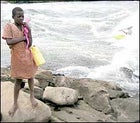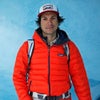In January 2004, top female kayakers from all over the globe joined medical doctor and expedition leader Jessie Stone in Uganda, to form the world’s first all-woman White Nile expedition. But this team’s goal was unique: Not only did they plan to conquer the river’s gnarly whitewater, they also hoped to aid the malaria-stricken villages lining its banks.

Throughout history, the Nile’s violent waters have traditionally been either feared and avoided or harnessed for energy. But its steep rocky channels and impressive 75,000-cubic-feet-per-second flow have lately been garnering international attention from many of the world’s most talented kayakers. Twenty-foot standing waves and waterfalls make the White Nile one of the most difficult rivers anywhere, a challenge top paddlers are finding hard to resist.
For Stone’s team, however, wet thrills were only half the mission. With 25 million people, Uganda is among the countries in Africa hit hardest by the deadly blood parasite, Plasmodium falciparum, spread by the female Anopheles gambiae mosquito. And within Uganda, no area is more susceptible than the banks of the Nile, where river water pools into stagnant mosquito swamps.
“Malaria is preventable but they are lacking good information and some basic prophylactics,” said Stone. “We’re taking on the problem from three angles: prevention, education, and treatment.” For the prevention portion of the project, Stone’s team organized a co-op of local women, led by Ugandan Jessica Mugerwa, to distribute mosquito netting—one of the most basic and potent methods of prevention.
“Our goal is to make the project self-sustaining,” explained Stone. “A cottage industry of mosquito netting will both prevent malaria and be a valuable source of income for the locals.”
Other kayakers—including Kiwi hair boater Niki Kelly (see �����ԹϺ���‘s December 2003 feature,), Montanan Kristen Read, known for her conservation work on the Futalafu; and Canadian freestyler Anna Levesque— focused on malaria education by providing information and demonstrating prevention techniques at local schools.
“Almost every family [in the area] has lost a child to the disease, and the pharmaceutical names for anti-malarial drugs are household words—it is pretty scary,” Kristen Read (who has traveled extensively in developing nations) wrote in a recent email.
In addition to these activities, Stone plans to distribute an ancient anti-malarial agent that has gained new popularity. Commonly known as annual wormwood, Artemisia annua produces a compound called artemisinin which is released from small sacks on the leaves and acts as a natural pesticide to protect the plant from parasites and predators. The leaves, when consumed as a tea, prevent malarial attacks in infected patients—though scientists are not sure exactly how artemisinin inhibits the disease.
“When I asked some African malaria doctors which treatments to use, they all said artemisia was what they are using,” said Stone. “We’re trying to work something out with one of the European drug companies now producing artemisinin in tablet form.”
The women’s expedition to Uganda was successful, but the bulk of Stone’s work still lies ahead. She’s formed a non-profit charity called Soft Power Health to complement Uganda-based Soft Power Education and is planning a May 6 benefit at Manhattan’s Allan Stone Gallery (www.allanstonegallery.com) to raise funds for a brick-and-mortar clinic in the village of Chybirwa. Read and Levesque will be hanging up their paddles and kayaks for a spell to join her there.
“It will take at least a few months before we can distribute the nets and see the results of children and adults getting bitten less, but I am very hopeful,” says Stone.
People interested in contributing to the project should email Jessie Stone at jessiechester@hotmail.com.


